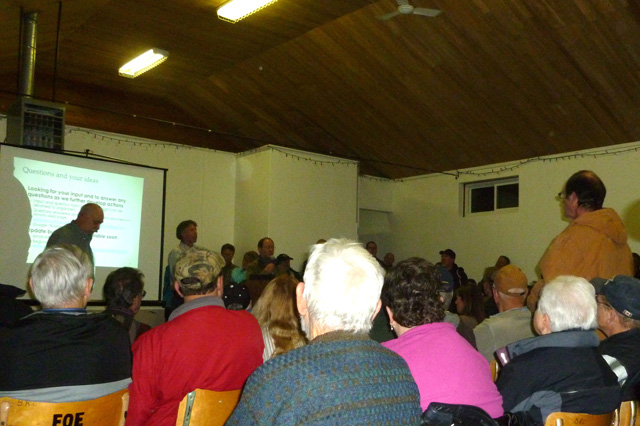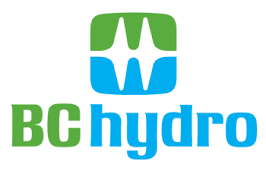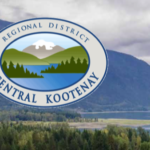Concern for flagging Kootenay Lake fishery draws big crowd
The short version is that there are too many mouths to feed.
The longer version is that it may take anywhere from two to ten years for the Kokanee to recover in Kootenay Lake and everyone has to help.
That was the message from Forest Lands and Natural Resource Operations (FLNRO) biologists who spoke to a packed meeting of more than 250 people at the Balfour Hall Monday night.
The meeting was called by the Balfour and District Business and Historic Association (BDBHA) as a result of growing environmental and economic concerns over the flagging fishery. One fishing derby has already been cancelled due to the small size of the Gerrards.
The crowd included representatives from every part of the main lake.
“My hope is that we can convince you that the ministry is taking this situation very seriously,” said John Krebs, FLNRO Director of Resource Management for the Kootenays.
“We all have a shared interest in the recovery of the Kootenay Lake system.”
The West Arm of the lake was not included in the discussion as the Kokanee are in good shape there, the crowd heard.
According to senior fisheries biologist Jeff Burrows and biologist Matt Neufeld, who gave scientific presentations at the opening of the meeting before a question period, the imbalance has been caused by high Gerrard rainbow trout numbers and low Kokanee numbers in the main lake in the last three years.
The Gerrard — who are now “skinny, long snakey looking things” — depend on the Kokanee as their food source.
Gerrard spawners peaked in 2012 and though they have declined in 2013 and 2014, both latter years are still well above the long term average.
In 2014 the estimate of Kootenay lake Kokanee spawners was the lowest on record at 150,000, as compared to an average 875,000 — about 17 percent. The next lowest year was in 1991.
And although female Kokanee were bigger and producing more eggs, the forecast is not good if other measures are not taken, the audience heard.
Those other measures include continuing the nutrient program, changing fishing regulations, cleaning spawning channels and supporting the efforts other stewardship groups around the lake.
The nutrients, which at one time included phosphorous along with the present agricultural grade nitrogen, are added to replace the nutrients trapped as a result of the Duncan and Libby dams.
“Quick Kokanee recovery depends on continued nutrients, optimizing time and input and increased monitoring,” Burrows said.
Spawning channels also must be drained and dried to prevent the spread of the infectious hematopoietic necrosis virus (IHNv) which was discovered on Kokanee in 2013.
Although the virus is believed to be spread by contact, not genetically, “there is no practical way of controlling the disease except at the spawning channels,” Burrows said.
However, the biologists do not think that IHNv is a significant factor.
On the angler side, Burrows said they are recommending a change in the fishing regulations to allow fishers to catch four Gerrard instead of two that are less than 50 cm to reduce the burgeoning young Gerrard population. They may also recommend decreasing the Kokanee catch.
“We are encouraging people to follow regulations, but don’t be shy about keeping the rainbow trout,” Burrows told the audience.
Ultimately, however it will be the “predator response” — the Gerrard — that will determine how quickly the Kokanee can recover said Neufeld, and at this point it is “an uncertainty.”
Questions and comments from the audience ranged from what is federal fisheries doing (nothing) to what about more spawning channels and transplanting fry (possible), is this more than a normal fluctuation (yes), could the problem be due to a parasite (not really), are anglers affecting the numbers (we don’t think so) and is algae increasing (a necessary part of the food chain for zooplankton which feed the Kokanee).
But the biggest round of applause was handed to Eileen Delahanty Pearkes when she reminded the crowd that BC earns on average $170 million from downstream benefits of the Columbia River Treaty and that both the Libby and the Duncan dams are treaty dams that have compromised Kootenay Lake’s fishery.
Overall, presenters were pleased with the turnout and the two-way conversation that took place, promising another meeting once a team of scientists have reviewed the plan for recovery.
“The depth of interest was impressive,” said John Krebs. “There’s more communication we could be doing to improve the understanding of the impacts on the fishery, and I saw a desire to be involved. Everyone wants to get their shovel in the dirt.”
Randy Zelonka, owner of Balfour’s Gill and Gift shop and president of the BDBHA said the meeting achieved his objective.
“The goal was to create awareness as to what’s happening out there,” he said. “We hope we are advised of the plan. Science is what is needed to return to productivity.”
But he said there is no doubt that the situation is having an economic impact on business. “My tackle sales are down, moorage is down, you don’t see the boats on the lake, the 20 pounders (rainbow) are not there.”
Zelonka said that another fishing derby in May may be cancelled. “We are looking into the feasibility of having it.”
Long time angler Randy De Biasio of Trail’s West Kootenay Big Game Trophy Association was not optimistic.
“I hope they’re right, but from what I saw, it’s the same as what happened in the ‘90s. It’s crashing and it’s going to continue to crash.”


























Comments